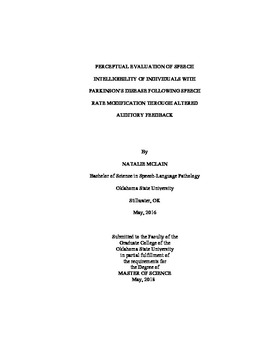| dc.contributor.advisor | Kaipa, Ramesh | |
| dc.contributor.author | McLain, Natalie | |
| dc.date.accessioned | 2019-03-25T21:41:17Z | |
| dc.date.available | 2019-03-25T21:41:17Z | |
| dc.date.issued | 2018-05-01 | |
| dc.identifier.uri | https://hdl.handle.net/11244/317760 | |
| dc.description.abstract | Parkinson's disease (PD) is a neurodegenerative, progressive disease that presents with numerous symptoms, including motor and non-motor (Jankovic, 2008). There has been some research to document that people with PD present with a characteristic accelerating speech rate, commonly referred to as festinating speech (Duffy, 2013; Skodda, 2011; Skodda & Schlegel, 2008). A commonly recommended technique to treat speech rate deficits in individuals with PD is rate reduction (Hammen & Yorkston, 1996; Tjaden & Wilding, 2011). A majority of the studies have demonstrated beneficial effects of rate reduction (Hammen & Yorkston, 1996; Tjaden & Wilding, 2011). Various rate reduction strategies have been used in the past to modify the speech rate in individuals with PD (Blanchet & Snyder, 2010). The use of altered auditory feedback (AAF) has received considerable attention as a treatment technique to modify the rate of speech. The two common types of AAF include delayed auditory feedback (DAF) and frequency shifted feedback (FSF). While examining the acoustic bases of rate reduction is important, it has limited ecological validity. It is imperative to examine if the rate reduction as reflected by acoustic parameters translates to improved speech intelligibility to the outside world. This is possible only by perceptual evaluation of the individual's speech intelligibility by naive listeners. The current study aims to evaluate the speech intelligibility in individuals with PD following rate modification using AAF. Five individuals with PD (clinical group) and five age-matched healthy controls (healthy group) aged 50 and above served as participants. Each participant was asked to read the grandfather passage, as well as give a monologue. They were first asked to complete these two tasks without the administration of AAF. Then, the participants were asked to do the same tasks again, but with the administration of AAF through a 150 millisecond delay and a pitch 1/20 octave higher. Thirty-two naive listeners were recruited to listen to the speech samples of the participants and give each sample an intelligibility rating. It is anticipated that delivering AAF will increase intelligibility in individuals diagnosed with PD by slowing down their rate. | |
| dc.format | application/pdf | |
| dc.language | en_US | |
| dc.rights | Copyright is held by the author who has granted the Oklahoma State University Library the non-exclusive right to share this material in its institutional repository. Contact Digital Library Services at lib-dls@okstate.edu or 405-744-9161 for the permission policy on the use, reproduction or distribution of this material. | |
| dc.title | Perceptual Evaluation of Speech Intelligibility of Individuals with Parkinson's Disease Following Speech Rate Modification Through Altered Auditory Feedback | |
| dc.contributor.committeeMember | Giddens, Cheryl L. | |
| dc.contributor.committeeMember | Copeland, Karen Annette | |
| osu.filename | McLain_okstate_0664M_15633.pdf | |
| osu.accesstype | Open Access | |
| dc.description.department | Communication Sciences and Disorders | |
| dc.type.genre | Thesis | |
| dc.type.material | text | |
